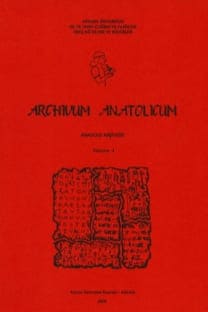HİTİTÇE ÇİVİ YAZILI METİNLERDE DEĞİRMEN (É NA4ARA5) VE ÖĞÜTME TAŞI (NA4ARA5)
Anadolu’nun MÖ 2. binyıldaki halkı Hititlerin ekonomisi öncelikle tarıma dayanmaktaydı. Onlardan günümüze ulaşan yazılı belgelerden tahılı öğüterek un haline getirdikleri, Hitit mutfağının temel yiyeceği olmasının yanı sıra tanrılarına yaptıkları sunularda da yer alan ekmeği elde ettikleri okunmaktadır. Ekmeğin hammaddesi olan unun elde edilmesi için tahılın öğütüldüğü değirmen, Hititçe çivi yazılı belgelerde É NA4ARA5 sumerogramı ile ifade edilmiştir. Değirmende ya da elde tahılın öğütülmesi işinde kullanılan öğütme taşı da NA4ARA5 ile ifade edilmiştir. Belgeler bize değirmende çalışanların daha çok kadınlar olduğunu göstermektedir. Bunlar köle kadınlar olmalıydılar. Bunun yanında erkeklerin de az da olsa değirmende çalışmış oldukları belgelenebilmektedir. Özellikle Maşathöyük Mektuplarından kör oldukları belirtilen erkeklerin değirmenlerde zorla çalıştırıldıklarını, fırsat bulduklarında kaçmaya teşebbüs ettiklerini öğrenmekteyiz.
Anahtar Kelimeler:
Hitit, çivi yazısı, değirmen, öğütme taşı
Mill (É NA4ARA5) and Grinding Stone (NA4ARA5) in Hittite Cuneiform Texts
The economy of the Hittites, the people of Anatolia in the 2nd millennium BC, was primarily based on agriculture. It is read from the Hittite cuneiform documents that they grind the grain into flour, and that they obtained the bread that was included in the offerings they made to their gods as well as being the main food of the Hittite cuisine. The mill where the grain was ground to obtain flour, the raw material of bread, is expressed with the sumerogram É NA4ARA5 in Hittite cuneiform documents. The grinding stone used to grind the grain in the mill or by hand is also denoted by NA4ARA5. The documents show that it was mostly women who worked in the mill. These supposed to be slave women. In addition, it can be documented that men worked in the mill, albeit a little. Especially from the Maşathöyük Letters, we learn that men, who were stated to be blind, were forced to work in the mills and attempted to escape whenever they could.
Keywords:
Hittite, cuneiform, mill, grinding stone,
___
- Alp, Sedat. Hethitische briefe aus Maşat-Höyük. Ankara: Türk Tarih Kurumu, 1991.
- Arıkan, Yasemin. “Hitit Belgelerinde Körler”, Archivum Anatolicum 4/1 (2000): 214-215.
- Arıkan, Yasemin. (2007) “An Official in Hittite Cult LÚtazzelli-”, Tabularia Hethaeorum Hethitologische Beiträge Silvin Košak zum 65. Geburtstag, Wiesbaden, ss. 33-58.
- Beckman, G.-Goedegebuure, P.-Hazenbos, J.-Cohen, Y. “Hittite Historical Texts I”, (ed. M. W. Chavalas), ANE, (2006): 215-252.
- CAD:Chicago Assyrian Dictionary, Vol E, Chicago: The Oriental Institute, 1958.
- Christiansen, Birgit. Schicksalsbestimmende Kommunikation, StBoT 53, Wiesbaden: Harrassowirz Verlag, 2012.
- Collins, Billie Jean. The Representation of Wild Animals in Hittite Texts. Ann Arbor: UMI Dissertation Services, 1989.
- Collins, Billie Jean. “The First Soldiers Oath (1.66)”, COS 1, (2003): 165-167.
- Daddi, Franca Pecchioli. Mestieri, professioni e dignita nell’Anatolia ittita, Roma: edizioni Delll’ateneo, 1982.
- de Martino, Stefano. Annali e Res Gestae Antico Ittiti, Pavia: Italian University Press, 2003.
- Hoffner, Harry A. Alimenta Hethaeorum, Food Production in Hittite Asia Minor. New Haven: American Oriental Society, 1974. Hoffner, Harry A. Hittite Myths, Atlanta: Society of Biblical Literature, 1998.
- Karauğuz, Güngör. Hititler Dönemi’nde Anadolu’da Ekmek, İstanbul: Arkeoloji ve Sanat Yayınları, 2007.
- McMahon, John Gregory The Hittite State Cult of the Tutelary Deities, Assyriological Studies 25, Chicago: Oriental Institute of the University of Chicago, 1991.
- Mouton, Alice. “Réflexions autour de la notian de ritüel initiatique en Anatolie Hittite. Au sujet la fete haššumaš (CTH 633)”, Journal of Ancient Near Eastern Religions 11, (2011): 1-38.
- Öz, Esma. Kültepe Metinleri Işığında Eski Anadolu’da Tarım ve Hayvancılık. Ankara: Türk Tarih Kurumu, 2014.
- Puhvel, Jaan. Hittite Etymological Dictionary, Berlin and New York: Walter de Gruyter, 1991.
- Rieken, Elizabeth. hethiter.net/: CTH 348.I.1, (Portal Mainz), 2009.
- Rieken, Elizabeth. hethiter.net/: CTH 376/1, (Portal Mainz), 2017.
- Singer, Itamar. Hittite Prayers, Leiden: Society of Biblical Literature, 2002.
- Trabazo, Jose Virgilio Garcia. Textos Religiosos Hititas, BCBO 6, Madrid: Editorial Trotta, 2002.
- Tuncer, Hasan. “Hititçe Çivi Yazılı Metinlerde Tanrı ile Kartal İlişkisi Üzerine Bir Değerlendirme”, 8th International Online Conference on Social Researches and Behavioral Sciences (SADAB-Bosna), Ed. Valeri Modebadze, Tuzla, (2021): 186-206.
- Ünal, Ahmet. The Hittite Ritual of Hantitaššu from the City of Hurma Against Troublesome Years, Ankara: Türk Tarih Kurumu, 1996.
- Ünal, Ahmet. Hititçe-Türkçe, Türkçe-Hititçe Büyük Sözlük, Ankara: Bilgin Kültür sanat Yayınları, 2016.
- ISSN: 1300-6355
- Yayın Aralığı: Yılda 2 Sayı
- Başlangıç: 1995
- Yayıncı: Ankara Üniversitesi
Sayıdaki Diğer Makaleler
HİTİTÇE METİNLERDE GIŠniniyalla- “BEŞİK” SÖZCÜĞÜ ÜZERİNE BİR İNCELEME
ANTİKÇAĞ FARMAKOLOJİSİNİN TEMELLERİ: ESKİ YUNAN TIBBINDA MATERIA MEDICA GELENEĞİ
YENİ BABİL DÖNEMİNDE TARIM POLİTİKALARI VE TARIMSAL ÜRETİM
SALLUSTIUS, FRAGMENTA HISTORIARUM, VI. MITHRIDATES’İN III. PHRAATES’E MEKTUBU
Ümit Fafo TELATAR, Evren SELEN DUMLUPINAR
İSKİT KRALI ATEAS VE II. PHILIPPOS
PRINCIPATUS DEVRİ KÜÇÜK ASYA’SINDA ROMALI MAGISTRATUS’LARIN İSMİYLE ANILAN AGON’LAR
BÜYÜK KRAL'DAN RAHİP TELİPİNU'YA BİR DİREKTİF (CTH 44)
HİTİTÇE ÇİVİ YAZILI METİNLERDE DEĞİRMEN (É NA4ARA5) VE ÖĞÜTME TAŞI (NA4ARA5)
YAZILI BELGELER IŞIĞINDA HELLENİSTİK DÖNEMDE HANEDANLAR: KARIA
HİTİTLERDE İKTİDARIN MEŞRUİYET ARACI OLARAK RÜYA : III. HATTUŠİLİ’NİN RÜYALARI
